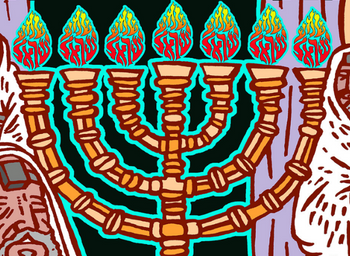Hanukkah Poster
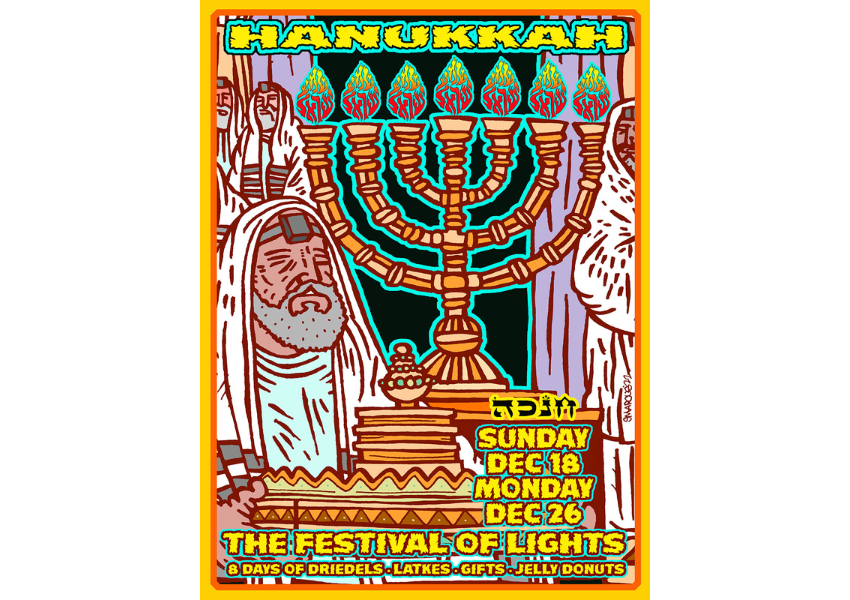
Hanukkah commemorates the recovery of Jerusalem and the rededication of the Second Holy Temple in the 2nd century BCE and is observed for 8 days and nights beginning on the 25th day of the Hebrew month of Kislev. The name Hanukkah can be broken down into חנו, “they rested [on the]”, and then using the numerical value of Hebrew letters (known as Gematria), by adding the sum of the the last two Hebrew letters, כ״ה, in the word Hanukkah together. The value of these last two letters, the letter Hay, the fifth letter (5) of the Hebrew alphabet, and the Chaf, the twentieth letter (20) of the Hebrew alphabet, has a sum of 25, which refers to the day the Jews ceased fighting on the 25th day of Kislev. So, Hanukkah means “they rested on the 25th”.
Hanukkah is celebrated with a menorah lighting. Each night, a candle is added from right to left to the menorah and the candles are lit while saying special prayers and singing songs. The spiritual light of the menorah spreads “light” into the darkness of the physical world.
This festive celebration is further enhanced by playing dreidel, eating chocolate gelt, giving gifts, and enjoying fried foods, which symbolizes the miracle of the oil. But, did you know that latkes, fried potato pancakes, were originally used as vehicles to eat sour cream? Yahudit (Judith), the heroine of Hanukkah, killed Holofernes, a mighty Syrian-Greek general, by seducing him with wine and cheese before killing him. This brave act of guerilla warfare is commemorated by eating dairy foods like sour cream, the perfect accompaniment for a latke.
Happy Hanukkah!
— Reb Simcha Yosef ben Yehuda Ha’Levi
AKA Steve Marcus, Artist
Hanukkah Poster (close up 1)
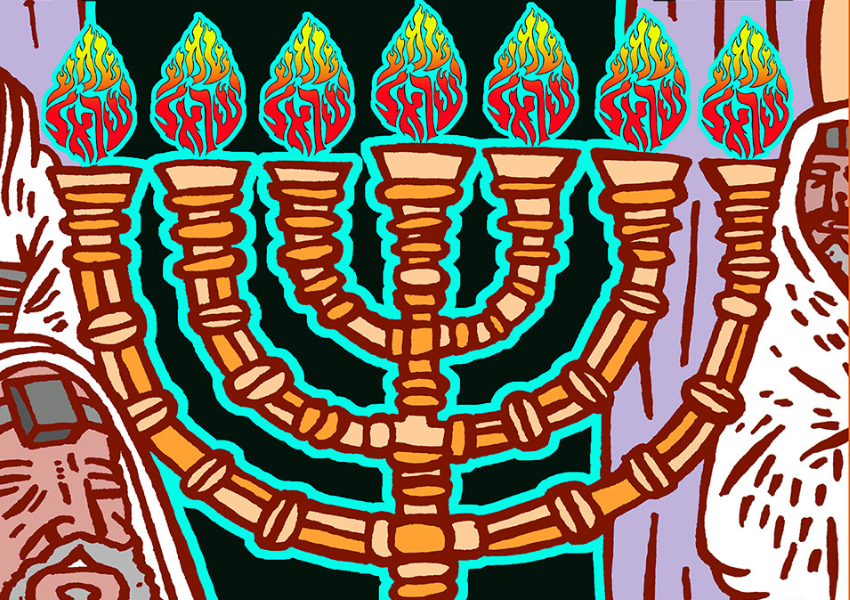
Hanukkah Poster (close up 2)
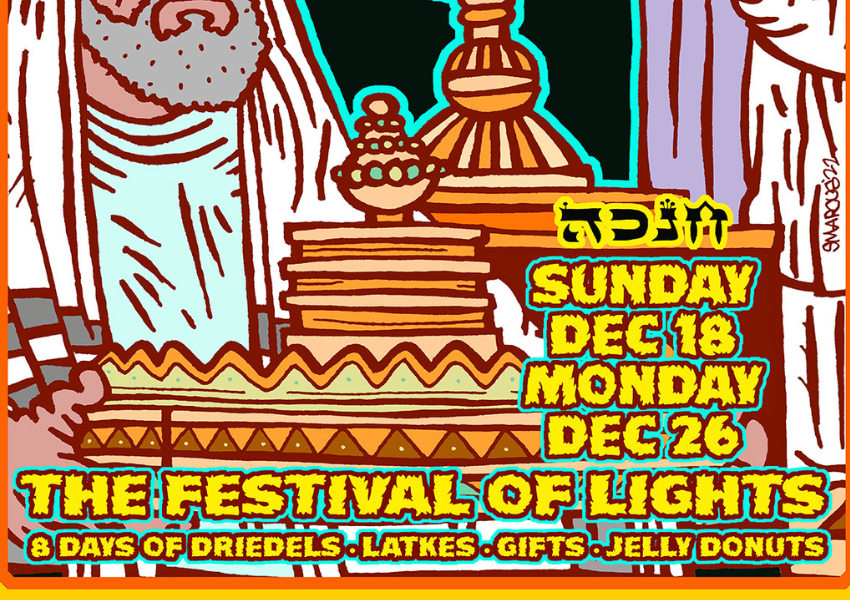
About the Poster Series
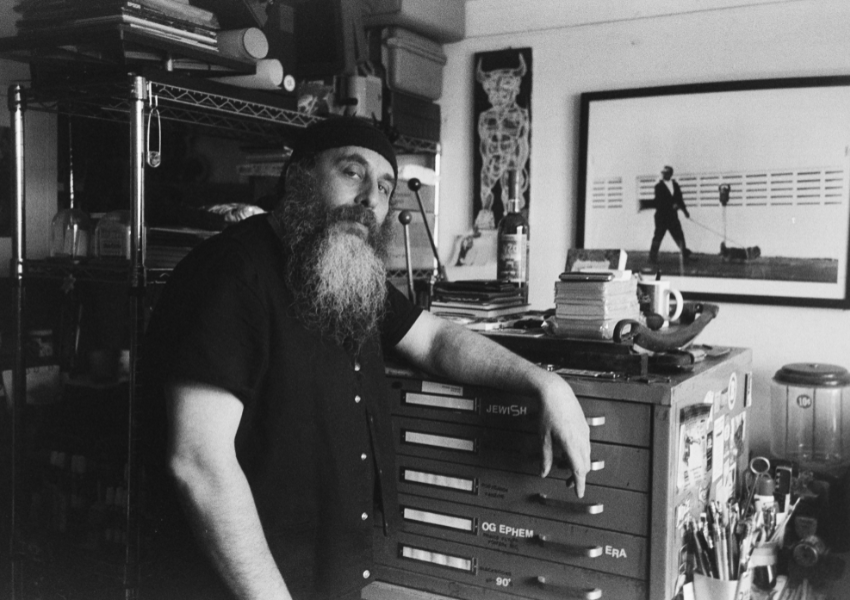
NYC Artist, Steve Marcus writes about his new series for the Jewish Arts Collaborative:
“There’s an old saying that a skilled laborer works with their hands, a craftsman with their hands and mind, but an artist works with their hands, mind, and heart. This trinity of the hands, mind, and heart is accessible for artistic manifestation by any human being, regardless of race, religion, ethnicity, sexual orientation, or gender. Within the mind-boggling diversity of the human population and its countless artists— now capable of tracing their ancestors’ origins to every corner of the globe— one may wonder, what makes art “ethnic”?
Ethnic art incorporates and expresses a specific people’s culture, history, and collective experience. When artisans and their work are both descended from a specific group’s said collective experience, and the artisan chooses to wrestle with the inner torment of the group’s reality with the hope of communicating the subtleties of their unique daily experience and thought processes, the subject of the work becomes the artisans themselves. The work can then be considered authentic “ethnic art”. However, not all art crafted by the hands of ethnic artisans can be classified as ethnic art. When craftspersons of distinct ethnicities create objects without ethnic content, the “ethnic” adjective refers to the artist and not the art. And if an artisan creates art that has ethnic content relating to an ethnicity that is not their own, then the ethnic adjective refers to the art and not the artisan. In this case, the artisan may be knowledgeable of the subject matter, so the art may mimic ethnicity, but it will not be informed by an authentic experience. The exploitation of that inner experience by someone from a separate culture amounts to “cultural appropriation”.
In the era of globalization, the ugliness of cultural appropriation has become rampant, as various “outside cultures” are now easily accessible with the assistance of the internet and social media. The digital-age specter of colonialism, imperialism and social Darwinism disseminates information and imagery at a dystopian pace. Consumers hijack distant cultures’ attitudes and style cues to mold themselves into the hipster approximations of cultures they have never experienced firsthand. This form of imitation is the stylistic manifestation of colonial imperialism and is helping to pave a bland and blind path toward a global monoculture.
Many descendants of the founders of monotheism are suckers for the global monoculture—no longer a nation within a nation, they are being absorbed into the matrix. The greatest existential threat to the Jewish people is the Jewish people themselves. The apologetic and sometimes dismissive attitude Jews have about being Jewish, to the point of assimilation, has left most Jewish artists and institutions struggling through a postmodern identity crisis. They’ve abandoned so much of their own intrinsic identity, creating art that begs for acceptance from their own tormentors. This current series of work for the Jewish Arts Collaborative expresses my own roots and culture by creating images for the annual festivals, holidays, and observances of the Jewish calendar, which proudly contain Jewish values as a celebration of authenticity. However, the artwork is not just a creative declaration of my own identity and beliefs but also created to inspire all people to celebrate and explore their own true identities in a creative rebellion that smashes falsehood and hatred. The quest for the truth will lead to oneness. Be strong and may we be strengthened.”
Steve Marcus (aka smarcus) has received honors and awards from the American Society of Illustrators and has several works in the art and American history collections in esteemed institutions, notably the Oakland Museum of California, The Jewish Museum of Florida – FIU, The Yiddish Book Center, The Harvard Library, Yivo Institute for Jewish Research and The Miami-Dade PLS. He is acknowledged as one of the Lower East Side’s most culturally influential residents in, “Jews: The People’s History of the Lower East Side” and his work is written about by professors from Ohio State University, Tulane University, Florida State University, Harvard University and in scholarly books published by Duke University Press, The University of Texas Press and the Florida International University. Steve is a member of the American Guild of Judaic Art.
This work was commissioned by the Jewish Arts Collaborative in 2022. Stay tuned for more posters in this series.
Other posters in this series: Tu BiShvat, Purim, Passover. Stay tuned for more.
JArts’ mission is to curate, celebrate, and build community around the diverse world of Jewish arts, culture, and creative expression. Our vision is of a more connected, engaged, and tolerant world inspired by Jewish arts and culture.
Reflections
I spy...
It's all in the details. What are some "hidden" details on the poster that catch your eye?
Assimilation
One of the central ideas of this series is a grappling with assimilation and the abandonment of identity. How does the artist's work embody authenticity and "creative rebellion"?
"Ethnic art"
What do you think makes a piece of art "ethnic"? How do you define "Jewish art"?
Want more?
Get curated JewishArts.org content in your inbox

